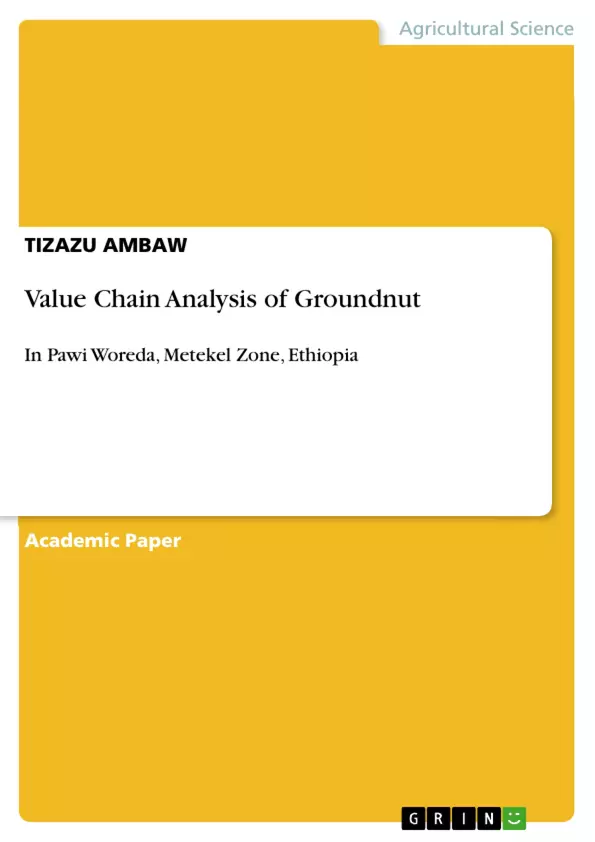This study was aimed at analyzing value chain of Groundnut in Pawi Woreda, Metekel Zone, Beni-shangul Gumuz Region with specific objectives of identifying groundnut value chain and examining the performance of actors in the chain; analyzing the determinants of groundnut supply to the market in the study area; and identifying and map marketing channels. The data were collected from both primary and secondary sources. The primary data for this study were collected from 155 farmers, 30 traders and 25 consumers through using questionnaires.
Descriptive statistics and Econometrics models were used to analyze the collected data. Results show that the main groundnut value chain actors in the study area groundnut producers/farmer, input suppliers, local assembler, wholesalers, retailers, Processers and consumers. It is also found out that groundnut passes through several intermediaries with little value being added before reaching the end users. The chain is governed by wholesalers and Processers who have capital advantage over the other chain actors. Therefore, farmers are forced to capture a lower share of profit margin.
The result of OLS regression model indicated that marketable supply is significantly affected by sex of household head, age of household head, agricultural extension service, owner ship of transport facility, distance of the nearest market and quantity of groundnut produced. Therefore, policy aiming at increasing farmers’ access to modern inputs, developing and improving infrastructure, gender consideration, and improving extension system are recommended to accelerate the chain’s development.
Inhaltsverzeichnis (Table of Contents)
- ABSTRACT
- ACKNOWLEDGEMENT
- DEDICATION
- CHAPTER ONE: INTRODUCTION
- 1.1 Background of the study
- 1.2 Statement of the problem
- 1.3 Objectives of the study
- 1.3.1 General objective
- 1.3.2 Specific objectives
- 1.4 Research questions
- 1.5 Significance of the study
- 1.6 Scope of the study
- 1.7 Limitation of the study
- 1.8 Organization of the study
- CHAPTER TWO: LITERATURE REVIEW
- 2.1 Concept of value chain and value chain analysis
- 2.2 Groundnut value chain analysis
- 2.3 Factors affecting value chain performance
- 2.4 Marketing channels and marketing efficiency
- 2.5 Marketing strategies to improve value chain performance
- 2.6 Groundnut value chain in Ethiopia
- CHAPTER THREE: MATERIALS AND METHODS
- 3.1 Study area
- 3.2 Data types and sources
- 3.3 Sampling techniques and sample size
- 3.4 Data collection tools and techniques
- 3.5 Data analysis methods
- CHAPTER FOUR: RESULTS AND DISCUSSIONS
- 4.1 Socio-economic characteristics of respondents
- 4.2 Value chain actors, activities and linkages
- 4.3 Performance of actors in the groundnut value chain
- 4.3.1 Farmers' performance
- 4.3.2 Traders' performance
- 4.3.3 Consumers' performance
- 4.4 Determinants of groundnut supply to the market
- 4.5 Marketing channels and marketing margins
- CHAPTER FIVE: CONCLUSIONS AND RECOMMENDATIONS
- 5.1 Conclusions
- 5.2 Recommendations
- REFERENCES
- APPENDICES
Zielsetzung und Themenschwerpunkte (Objectives and Key Themes)
This thesis examines the groundnut value chain in Pawi Woreda, Metekel Zone, Ethiopia, with the aim of identifying and analyzing the key actors, activities, and performance of the value chain. The objectives are to identify the groundnut value chain, examine the performance of actors in the chain, analyze the determinants of groundnut supply to the market, and identify and map marketing channels.- The study focuses on identifying and analyzing the key actors involved in the groundnut value chain.
- The thesis investigates the performance of various actors in the chain, evaluating their contributions and challenges.
- It explores the factors that influence the supply of groundnut to the market, particularly focusing on the role of farmer characteristics and market access.
- The research examines the different marketing channels used by groundnut producers and traders, analyzing their effectiveness and efficiency.
- The study highlights the importance of developing strategies to improve the performance of the groundnut value chain and increase the benefits for producers.
Zusammenfassung der Kapitel (Chapter Summaries)
- Chapter One provides a detailed introduction to the study, outlining the background, problem statement, objectives, research questions, significance, scope, limitations, and organization of the research. It also explains the context of the study by focusing on the importance of the groundnut value chain in the Ethiopian economy.
- Chapter Two reviews the existing literature on value chain analysis, groundnut value chain analysis, factors affecting value chain performance, marketing channels and marketing efficiency, marketing strategies to improve value chain performance, and groundnut value chain in Ethiopia. It provides a theoretical framework for the study and highlights the key concepts and issues relevant to the research.
- Chapter Three describes the methodology used in the study, including the study area, data types and sources, sampling techniques and sample size, data collection tools and techniques, and data analysis methods. It explains how the data was collected and analyzed, providing the reader with a clear understanding of the research approach.
- Chapter Four presents and discusses the findings of the study, including the socio-economic characteristics of respondents, value chain actors, activities and linkages, performance of actors in the groundnut value chain, determinants of groundnut supply to the market, and marketing channels and marketing margins. It analyzes the data collected and presents the key insights and observations from the study.
Schlüsselwörter (Keywords)
The key words and focus topics of this text include groundnut value chain, value chain analysis, agricultural economics, Ethiopia, marketing channels, supply chain management, farmer performance, market access, determinants of supply, marketing margins, and policy recommendations. This thesis investigates the dynamics of the groundnut value chain in Pawi Woreda, analyzing the performance of different actors, the factors affecting supply, and the potential for improving the efficiency and profitability of the chain.- Citar trabajo
- TIZAZU AMBAW (Autor), 2019, Value Chain Analysis of Groundnut, Múnich, GRIN Verlag, https://www.grin.com/document/505489



